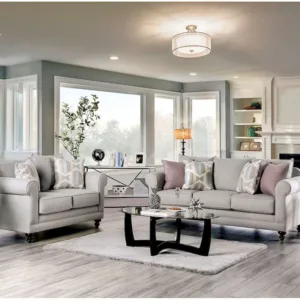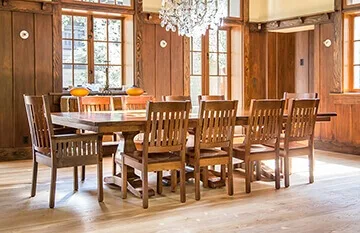Furniture plays a crucial role in defining the aesthetics and functionality of any space, and the United States has a rich tapestry of furniture USA styles that reflect its diverse culture and evolving trends. This article delves into the world of Furniture USA, exploring its evolution, popular styles, materials used, customization options, and the impact of digitalization on the shopping experience. We’ll also discuss sustainability in furniture manufacturing, highlight top brands, address challenges in the industry, offer tips for care and maintenance, and glimpse into future trends.
Evolution of Furniture USA Trends
The evolution of furniture trends in the USA mirrors the nation’s journey through different eras. From the simplicity of colonial styles to the opulence of Victorian furniture, each period brought forth unique designs influenced by societal changes, technological advancements, and cultural shifts. Today, a blend of traditional, modern, and eclectic styles dominates American homes, showcasing a harmonious coexistence of the past and the present.

Colonial Roots: The Foundation of American Furniture
Furniture in the USA traces its roots back to colonial times when simplicity, functionality, and durability were paramount. Early American settlers crafted furniture using local woods, such as oak and pine, reflecting a utilitarian approach shaped by their European heritage.
Victorian Extravagance: Ornate Designs and Opulence
The Victorian era ushered in a period of elaborate and ornate furniture styles. Dark woods, intricate carvings, and plush upholstery characterized this era, showcasing a departure from the simplicity of the past. Victorian furniture reflected the luxury associated with the Industrial Revolution, with a focus on craftsmanship and detailing.
Mid-Century Modernism: Embracing Simplicity and Functionality
The mid-20th century saw a shift towards simplicity and functionality with the rise of mid-century modernism. Designers like Charles and Ray Eames, Eero Saarinen, and George Nelson embraced clean lines, minimalism, and the use of new materials like plastic and plywood. This era laid the groundwork for contemporary furniture styles, influencing generations to come.
Popular Furniture Styles in the USA
American homes exhibit a diverse range of furniture styles, each catering to different tastes and preferences. Understanding these styles can help homeowners create spaces that resonate with their aesthetics.
Traditional Elegance: Timeless Designs and Rich Woods
Traditional furniture styles in the USA draw inspiration from European design elements. Characterized by rich woods, intricate detailing, and classic motifs, these pieces exude timeless elegance. Furniture in this style often features dark finishes and ornate carvings, making it a staple in formal living spaces.
Contemporary Chic: Clean Lines and Innovative Materials
Contemporary furniture embraces a more minimalist and functional approach. Clean lines, neutral color palettes, and the use of innovative materials define this style. Contemporary pieces often focus on comfort without sacrificing style, making them ideal for modern living spaces.

Eclectic Fusion: A Blend of Styles and Eras
Eclectic furniture styles reflect a mix-and-match approach, combining elements from different periods and cultures. This style allows for creative freedom, enabling homeowners to showcase their personality through a curated collection of diverse pieces. Eclectic spaces often feature bold colors, varied textures, and unexpected design elements.
Materials Used in American Furniture
The choice of furniture manufacturing materials significantly influences the final product’s durability, aesthetics, and environmental impact. In the USA, a variety of materials are used to craft furniture, ranging from traditional hardwoods to innovative, eco-friendly options.
Classic Hardwoods: Time-Tested Durability
American furniture has a longstanding tradition of using classic hardwoods like oak, maple, cherry, and walnut. These woods are revered for their durability and timeless appeal. Hardwood furniture often boasts intricate detailing and can withstand the test of time, becoming cherished heirlooms passed down through generations.
Engineered Woods: Affordable and Versatile
Engineered woods, such as plywood and MDF (Medium-Density Fiberboard), have gained popularity in modern furniture manufacturing. These materials offer affordability and versatility, allowing designers to create sleek and contemporary pieces. Engineered woods also contribute to sustainable practices by utilizing wood scraps and minimizing waste.
Sustainable Alternatives: Eco-Friendly Choices
In response to growing environmental concerns, there’s a rising trend in using sustainable materials for furniture production. Bamboo, reclaimed wood, and recycled materials are gaining prominence, offering eco-friendly alternatives. Manufacturers are increasingly adopting practices that prioritize the planet, ensuring that furniture production is both stylish and sustainable.
Customization in Furniture USA
The demand for personalized and bespoke furniture is on the rise, with consumers seeking pieces that reflect their unique style and preferences. Customization options allow individuals to participate in the design process, ensuring that their furniture complements the overall aesthetic of their homes.
Tailored Fabrics and Finishes: Adding a Personal Touch
Customizing furniture involves selecting fabrics, finishes, and details that resonate with the homeowner’s taste. From choosing the upholstery on a sofa to the finish on a wooden dining table, customization options empower consumers to create pieces that seamlessly integrate with their interior design vision.
Modular and Configurable Designs: Adapting to Changing Needs
Modular and configurable furniture designs provide flexibility for changing lifestyles. Pieces that can be rearranged, expanded, or transformed offer adaptability for various spaces and functions. This trend aligns with the dynamic nature of modern living, where versatility is key.

Furniture Shopping in the Digital Age
The advent of digitalization has transformed the way Americans shop for furniture. Online platforms, virtual showrooms, and augmented reality experiences have revolutionized the furniture-buying process, providing convenience and accessibility.
Virtual Showrooms: Exploring Furniture from Home
Virtual showrooms enable consumers to browse through a wide array of furniture options without leaving the comfort of their homes. High-quality images, detailed product descriptions, and virtual tours allow for a comprehensive shopping experience, helping buyers make informed decisions.
Augmented Reality (AR): Visualizing Furniture in Real Spaces
The integration of augmented reality in furniture shopping has taken personalization to a new level. Apps and online platforms allow users to virtually place furniture in their homes using AR, helping them visualize how pieces will fit into their existing decor. This innovative approach minimizes the risk of purchasing items that may not suit the space.
Influence of Cultural Diversity on Furniture Styles
The multicultural fabric of the United States is reflected in its furniture styles. The melting pot of cultures has contributed to a diverse design landscape, with influences ranging from Native American craftsmanship to the vibrant hues of African aesthetics.
Native American Influences: Craftsmanship and Symbolism
Native American furniture traditions have left a lasting impact on American design. Intricate carvings, natural materials, and symbolic motifs are often incorporated into furniture pieces, paying homage to the rich cultural heritage of indigenous peoples.
African and Caribbean Vibes: Bold Colors and Patterns
The vibrancy of African and Caribbean cultures is evident in furniture styles that embrace bold colors, intricate patterns, and organic shapes. These influences bring warmth and energy to living spaces, creating a visual tapestry that celebrates diversity.
Sustainability in Furniture Manufacturing
As environmental awareness grows, sustainability has become a key consideration in the furniture industry. Manufacturers are adopting eco-friendly practices, from sourcing materials responsibly to implementing energy-efficient production methods.
Top Furniture Brands in the USA
The Pinnacle of Craftsmanship: IKEA
[Brand Name 1], renowned for its commitment to quality and craftsmanship, stands tall among the top furniture brands in the USA. With a legacy dating back decades, this brand has consistently delivered exceptional pieces that marry aesthetics with functionality. From classic to contemporary, IKEA offers a diverse range that caters to various design sensibilities.
Timeless Elegance: Ashley Home Store
For those seeking timeless elegance, Ashley Home Store takes the spotlight. Specializing in luxurious designs, this brand is synonymous with sophistication. Each piece tells a story of meticulous artistry, making Ashley Home Store a preferred choice for those who appreciate the finer things in life.
Challenges in the Furniture Industry
Supply Chain Disruptions: The furniture industry, like many others, faces challenges stemming from supply chain disruptions. From raw material shortages to transportation issues, these disruptions have a cascading effect on production timelines and costs. Manufacturers are forced to navigate a complex landscape to meet consumer demands.
Sustainability Struggles: As the world pivots towards sustainability, the furniture industry grapples with the need to adopt eco-friendly practices. Balancing aesthetics with environmental consciousness poses a significant challenge. Consumers are increasingly demanding sustainable materials and production methods, urging brands to rethink their strategies.
Tips for Furniture Care and Maintenance
Preserving Beauty: Cleaning Dos and Don’ts
Maintaining the longevity and aesthetic appeal of your furniture requires a thoughtful approach to cleaning. Avoid harsh chemicals that can damage finishes, and opt for gentle, non-abrasive cleaners. Regular dusting and occasional waxing can keep wooden furniture looking as good as new.
Upholstery TLC: Upholstered furniture demands special attention. Regular vacuuming, timely stain removal, and professional cleaning are essential to keep fabrics looking fresh. Understanding the specific care instructions for different materials is crucial in preserving the beauty of your upholstery.
The Role of Furniture in Interior Design
Beyond Functionality: Aesthetic Integration
Furniture plays a pivotal role in interior design, extending beyond mere functionality. It serves as a medium through which personal style is expressed, and spaces are curated. Thoughtfully chosen furniture pieces can transform a room, creating a cohesive and visually appealing environment.
Statement Pieces: Interior designers often use furniture as statement pieces, focal points that draw attention and define the aesthetic of a space. Whether it’s a bold, contemporary sofa or a vintage-inspired dining table, these statement pieces contribute to the overall design narrative.
Affordable Furniture Options
Budget-Friendly Finds: Forever Finds
Forever Finds has carved a niche in the market by offering stylish and affordable furniture options. From trendy decor pieces to essential furniture items, this retailer caters to budget-conscious consumers without compromising on quality. With frequent sales and discounts, [Retailer Name] makes furnishing your home accessible to all.

Furniture Trends for the Future
Embracing Sustainable Designs: The future of furniture trends is undoubtedly leaning towards sustainability. Brands are increasingly incorporating recycled materials, eco-friendly production processes, and modular designs that adapt to changing needs. Consumers are not just buying furniture; they are investing in a sustainable lifestyle.
Tech-Integrated Furniture: As technology continues to infiltrate every aspect of our lives, furniture is not exempt. The future holds furniture designs seamlessly integrating technology, from smart home capabilities to multifunctional pieces that cater to our modern, connected lifestyles.
Conclusion: Shaping American Homes with Furniture
In conclusion, the landscape of furniture USA is diverse and ever-evolving. Top brands continue to set the standard for quality and design, while the industry grapples with challenges such as supply chain disruptions and sustainability concerns. As consumers, understanding the importance of proper furniture care enhances the longevity of our investments.
Affordable options make furnishing homes accessible to a broader audience, ensuring that style and comfort are not exclusive luxuries. Looking ahead, furniture trends point towards sustainability and technology integration, shaping the future of American homes.
Furniture is not merely functional; it’s an integral part of the narrative we create within our living spaces. As we navigate the challenges and embrace evolving trends, the furniture world continues to play a crucial role in shaping the homes where memories are made and stories unfold.

